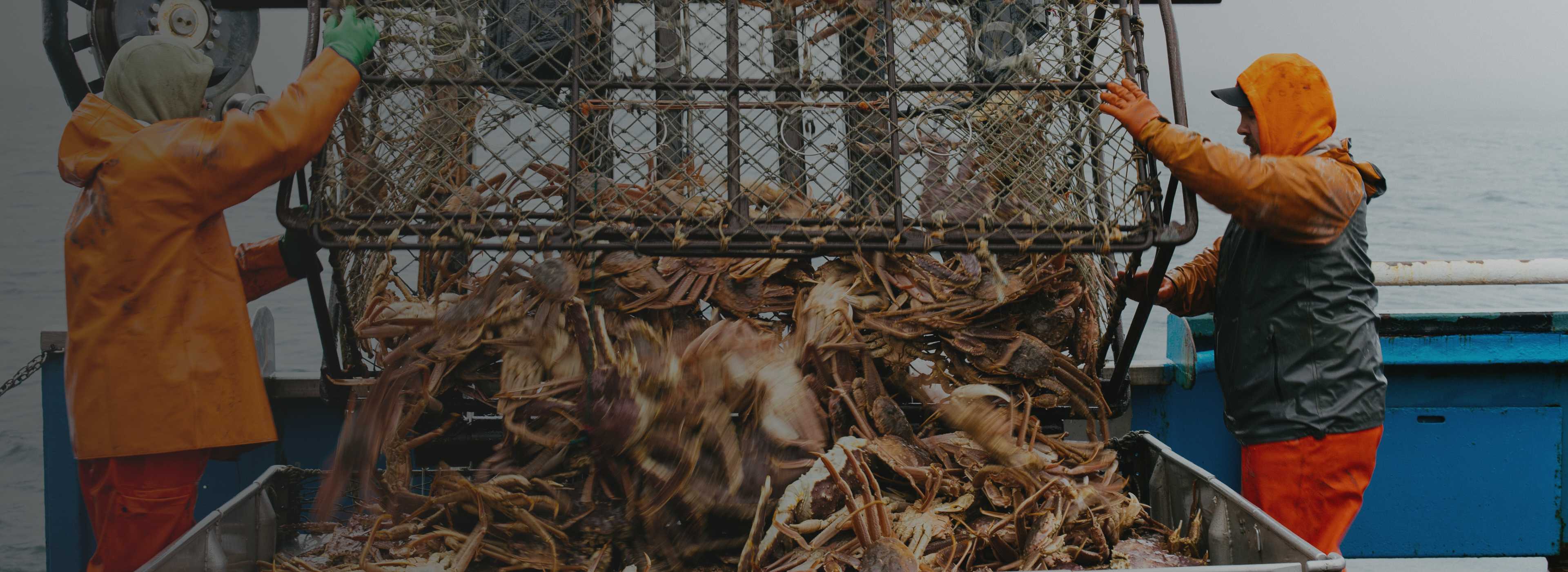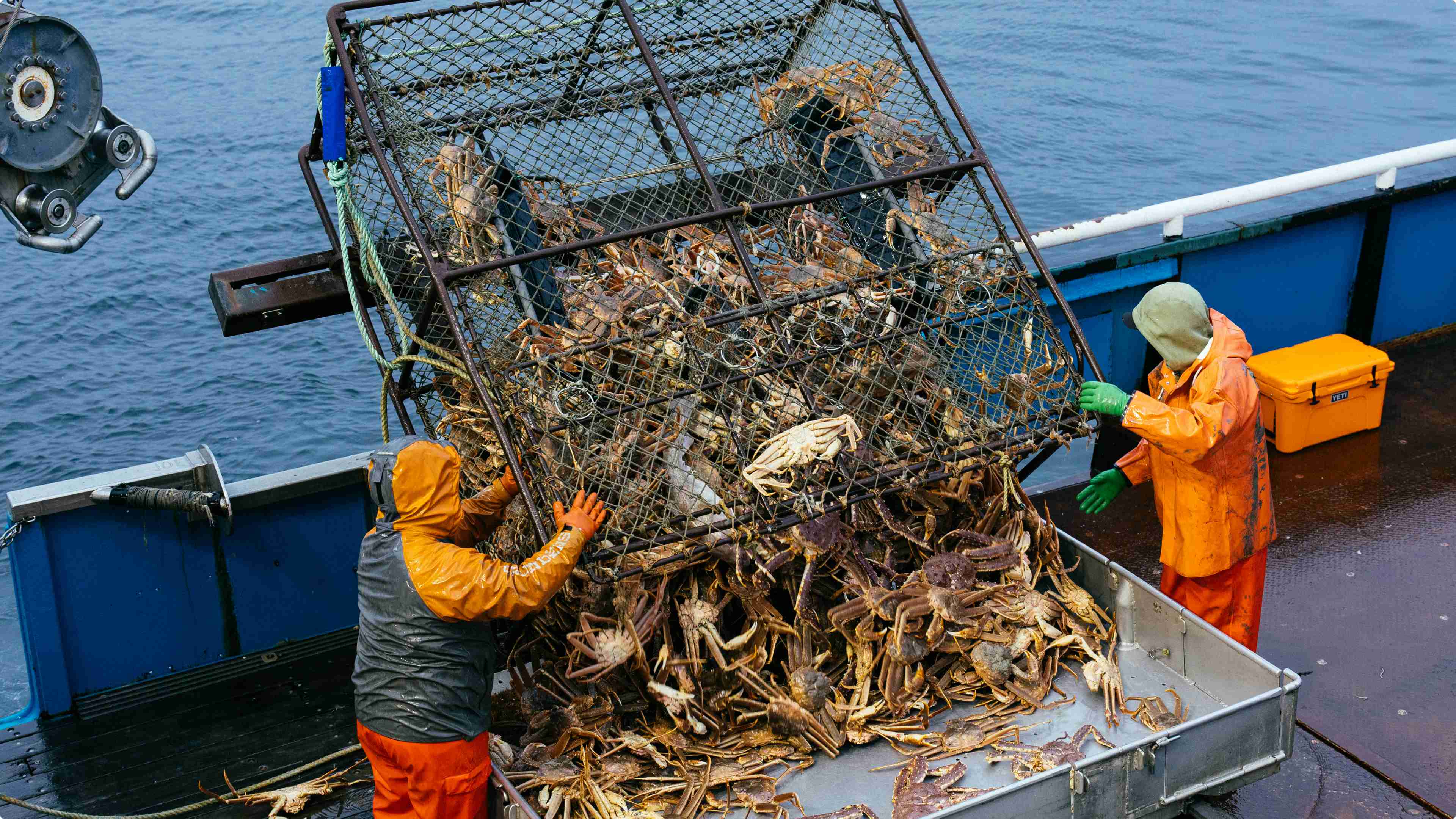
In 2023, the king crab season had a different feel to it. This season came after two years of closures due to too-low population numbers, which meant that the sustainability efforts implemented were making a positive impact. Gabriel Prout, a third-generation Bering Sea crab fisherman, and the president of the Alaska Bering Sea Crabbers trade group shares why he feels optimistic about the outlook on crab populations in the region.
There was a lot of excitement and optimism among the crews when the announcement came that the Bristol Bay red king crab season would be opening this year. The 2021 and 2022 season closures hit our community hard. But for those of us with careers on the Bering Sea, the closures weren’t a surprise, as we had seen the king crab population experience a steady decline for a decade. Nevertheless, the closures were a disappointment. So it felt great to be back on the water in October.
Nearly 50% of the United States’ crab is fished and landed in the Bering Sea – including snow crab, Tanner crab, Dungeness crab, and three species of king crab. Interestingly, Dungeness crab is seeing a population increase, along with moderate increases in the Tanner crab species. But the snow crab season is closed for its second season this year. When it comes to understanding the resource and how to protect it, there’s still a lot to learn.
F/V SILVER SPRAY: A FAMILY BUSINESS
My two brothers, Sterling and Ashlan, along with myself, represent the third generation of Alaskan fishermen in our family, and the second generation of Bering Sea Crab fishermen. My dad, Bill, is the head skipper on our fishing vessel (denoted as F/V) the Silver Spray, and has over 45 years of experience on the icy Alaskan waters. My wife, Bailey, also works as crew aboard the boat. It is a true family business.
During crab season, we’ll be at sea for three to four weeks at a time, hustling every day in the cold, wet, and salty environment. The intense conditions, long hours, threat of imminent danger, and close quarters can make it challenging on relationships, but at the end of the day, it’s a special thing to share it with family — both the hardships and successes. We understand each other very well, and I have better trust and respect for the work my brothers and my dad are doing.
But we aren’t the only small business on the water. In fact, I would say 90% of the vessels that participate in the harvest are individual fishermen, and from there I’d say at least 25% have some type of family working for them during crab season. There are a few corporate boats that are owned by the processors (the same processors that purchase our catch from us), but by and large, it is individual small business fishermen out there.
 ABOVE: Gabriel Prout pours ocean water on their catch before they are placed in holding tanks, ensuring they stay fresh and healthy while on the ship.
ABOVE: Gabriel Prout pours ocean water on their catch before they are placed in holding tanks, ensuring they stay fresh and healthy while on the ship.

BERING SEA TO D.C.
My first time crabbing on the Bering Sea wasn’t until the fall of 2016 when I participated in the red king crab season immediately after I graduated from college. The rough weather, long hours, and harsh environment made for a rude awakening after the cushy college experience of sleeping in, having real weekends, and not having a “boss.” While I was grateful for the experience, I wasn’t sold on being a Bering Sea crab fisherman.
“IT’S HARD TO GET AWAY FROM FISHING WHEN IT’S IN YOUR BLOOD.”
My sister who worked on Capitol Hill in D.C., was able to help me secure a job far from the cold conditions I had just experienced. But during my time on Capitol Hill, I learned that I didn’t particularly like office work and I missed the challenge and experience of being on the water. It’s hard to get away from fishing when it’s in your blood. So I quit my D.C. job to work on the boat the following year as a full-time crew member.
But that time in D.C. gave me a lot of valuable experience. There’s a lot of politicking with the fishery with the regulations that go into conservation. Being raised in a fishing and crabbing family has taught me the ins and outs of the resource, the business, and the way of life. And now my experience in D.C. with the Alaska Bering Sea Crabbers trade group is teaching me how to protect them.
 ABOVE: A crab pot is emptied onto the sorting table aboard the Silver Spray. The crew can quickly sort legal size crab into the tank, and place females and small crab back into the ocean in a matter of minutes.
ABOVE: A crab pot is emptied onto the sorting table aboard the Silver Spray. The crew can quickly sort legal size crab into the tank, and place females and small crab back into the ocean in a matter of minutes.
JOINING THE ABSC
The Alaska Bering Sea Crabbers website puts it best: “We lean on sound science paired with on-the-water experience and fishermen’s knowledge to work proactively and collaboratively towards positive outcomes that keep crab sustainable, conserve habitat and ecosystems, and keep fishermen fishing.”
When I joined the family business, I still knew I wanted to get more involved in the political side of things so I became a board member of the Alaska Bering Sea Crabbers trade group in 2019, and just recently they elected me President of the ABSC board.
I was a unique candidate for the board presidency in that I am an active commercial fisherman primarily focused on crab out in the Bering Sea, and also have experience on Capitol Hill. Plus not a lot of fishermen have a desire to put on a suit and lobby in D.C.
Working in both places, I get to see how the rules and laws I advocate for are implemented to protect this resource, and see the effects of our efforts on sustainability. The goal is to preserve this resource for the next generation of fishermen like myself.
“KING CRAB HAS A SPECIAL PLACE IN FISHERMEN’S HEARTS. IT HOLDS THE ALLURE OF GOING OUT FOR AN ICONIC SPECIES.”
Something the ABSC trade group is focusing on that will directly impact the consumer is that we are working on Country Of Origin Labeling, for not just crab, but seafood in general. We’re lobbying for that because consumers not only like to know where their food is coming from, but they have a right to know what their dollar is helping support.
When consumers can choose to support American fishermen through proper labeling, it helps get American fishermen a better and more fair price and also helps support sustainability by purchasing responsibly sourced seafood.

ABOVE: Bailey Prout measures each king crab on the sorting table to make sure it’s the legal size allowed for retention.

ABOVE: Female crabs and sub-legal males all go back into the water to grow and reproduce for future seasons. Their trip from the bottom of the ocean, to the sorting table, and back into the water takes less than 10 minutes.
WATCHING THE (CRAB) POT
While the 2023-24 season had us back on the water for king crab, the work is not done. When a species’ population is in decline, it’s a complex issue with many factors in play – both naturally occurring and man-made.
Understanding how these intricate systems are impacted requires continued research and persistent efforts by all industry members to preserve the sustainability of crab stock when it is at low levels of abundance, regardless of the cause.
ABOVE: The crew of the Silver Spray constantly checks their gear for any issues, as well as making sure the pots that are onboard are secured and tied down properly.
CRAB BOATS: THE NEW RESEARCH VESSEL
This year, the crew of the Silver Spray, including myself, were selected from a lottery to be part of a new research initiative from the NOAA and the Alaska Department of Fish and Game. Over a dozen vessels opted to participate in the program.
We went out on the Bering Sea from March 10th through April 10th to set some pots for survey and research and to understand the distribution of red king crabs. This was particularly special because during this time no one else is setting pots (crab harvest season starts October 15th and ends January 15th) and the NOAA vessels aren’t doing their survey for crab stocks until mid-May. So we’re researching at a time of year when no fishing activity occurs for them.
A study like this hasn’t been done in nearly 40 years, so this was a very exciting opportunity and a privilege to be part of. It’s also encouraging that NOAA and ADFG are putting up money for this type of research. This initiative also put essentially out-of-work crab boats to use as research platforms. The valuable data learned from this survey will help inform management decisions to protect all crab stocks within the Bering Sea and we will be putting our name in the hat again to be part of next year’s research.
 ABOVE: When the Silver Spray is on the water fishing for crab, they often enjoy a bit of their catch right on the boat, or as they put it, “eating their paycheck.”
ABOVE: When the Silver Spray is on the water fishing for crab, they often enjoy a bit of their catch right on the boat, or as they put it, “eating their paycheck.”